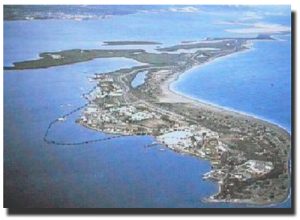Port Royal, Jamaica Project
Principal Investigator: Dr. Donny L. Hamilton
 Once known as the 'Wickedest City on Earth,' Port Royal on the island of Jamaica was one of the largest towns in the English colonies during the late 17th century. It was a haven for privateers and pirates, such as the famed Sir Henry Morgan, due to its excellent geographic location in the middle of the Caribbean. From Port Royal, these buccaneers preyed upon and plundered the heavily laden treasure fleets departing from the Spanish Main.
Once known as the 'Wickedest City on Earth,' Port Royal on the island of Jamaica was one of the largest towns in the English colonies during the late 17th century. It was a haven for privateers and pirates, such as the famed Sir Henry Morgan, due to its excellent geographic location in the middle of the Caribbean. From Port Royal, these buccaneers preyed upon and plundered the heavily laden treasure fleets departing from the Spanish Main.
After 1670, the importance of Port Royal and Jamaica to England was increasingly due to trade in slaves, sugar, and raw materials. It soon became the mercantile center of the Caribbean area, with vast amounts of goods flowing in and out of the port through an expansive trade network.
 Unfortunately, the glory of Port Royal was short-lived. On the morning of June 7th, 1692, a massive earthquake hit Jamaica. The tremors rocked the sandy peninsula on which the town was built, causing buildings to slide and disappear beneath the sea. An estimated 2000 Port Royalists were killed immediately in the disaster. Many more perished from injuries and disease in the following days.
Unfortunately, the glory of Port Royal was short-lived. On the morning of June 7th, 1692, a massive earthquake hit Jamaica. The tremors rocked the sandy peninsula on which the town was built, causing buildings to slide and disappear beneath the sea. An estimated 2000 Port Royalists were killed immediately in the disaster. Many more perished from injuries and disease in the following days.
From 1981 to 1990, the Institute of Nautical Archaeology, in cooperation with the Nautical Archaeology Program at Texas A&M University and the Jamaica National Heritage Trust, began underwater archaeological investigations of the submerged portion of Port Royal. The following pages highlight what we have found so far. The last excavation season was in 1990 and no further excavations are planned.
The last TAMU/INA excavation at Port Royal was conducted in 1990, at present there are no plans to undertake any further excavations.
Contract Services
The CRL works with a variety of academic institutions, museums, historical societies, government offices, and private individuals. Our goal is to create viable conservation strategies of the highest standard that can be accomplished at minimal cost. For more information, visit our services page.
Support
Monetary donations and volunteer workers are vital to the ongoing success of the Conservation Research Laboratory. If you would like to volunteer your time and expertise, please write us here. If you would like to become one of our donors, please click the link below and direct your gift to: Center for Maritime Archaeology and Conservation.
